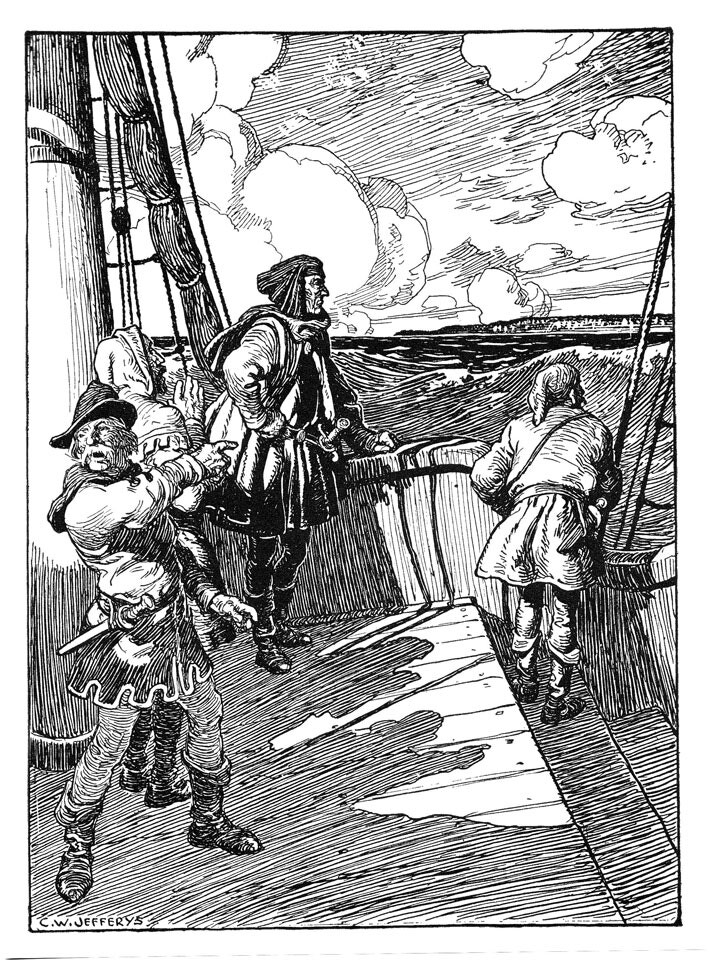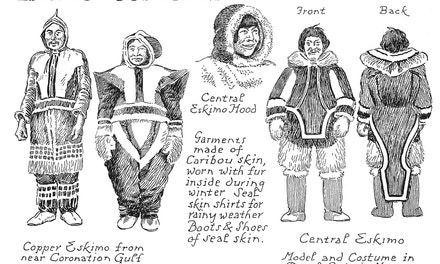Cabot and the New Found Land, 1497
Also titled:
- "Cabot sights the coast of America"
- “John Cabot sighting North America, 1497”
- “The new found land. Cabot’s first sight of North America”
- “John Cabot sights America”
- “John Cabot sighting the New Found Land, 1497”
- Credit: Library and Archives Canada, Acc. No. 1972-26-1
Copyright: Expired
Remarks
C.W. Jefferys' notes about this picture from Dramatic Episodes in Canada's Story
In the summer of 1493 the news had spread throughout Europe that a sea captain of Genoa, one Christopher Columbus, had sailed across the Western Ocean for the King of Spain, and found the Indies. Neither he nor any other man then knew that the land he had found was an unknown continent which lay between the old European world and Asia. Many men had dreamed of a way to the Orient by a western voyage. Among them was another native of Genoa, Giovanni Cabotto, or John Cabot,* as later he came to be called. In 1461, Cabot went to Venice and became a citizen of that great trading port, and spent many years voyaging in the Eastern Mediterranean and the Red Sea. Here he learned much about the countries of the far East, of India and Persia and China, heard tales of rich and populous cities, of royal palaces, and great temples, of mines of gold and precious stones, and of the wealth to be gained by the trade in silks and spices.
In 1484 he went to England with the Venetian traders and settled there for some years. Cabot knew that he could not interest the merchants of Venice in his project of a western route to Asia, since if that were established, Venice would be no longer the great importing centre for the products of the East. Both he and Columbus realized that their hopes lay in interesting the countries on the Atlantic seaboard in the new route. So, while Columbus went to Portugal and Spain, Cabot sought to attract the merchants and rulers of England by the prospects of the plan he had in mind. He talked to the merchants of London and Bristol, the two great English seaports of that time; but none ventured to support the experiment. Then came the news of what Columbus and the Spaniards had done. Cabot's idea had been shown to be possible, and the hard-headed English merchants began to think more favourably of his visionary project. In the winter of 1495-6 the King of England, Henry VII, visited Bristol. He was shrewd, cautious and money loving. In Bristol, no doubt, he heard much about Cabot and his plans. Probably he listened to Cabot himself. He became interested, and he gave Cabot and his sons permission to make a voyage to sail under the King's colours, and, in the language of his charter, authorized them to take possession of any cities, islands or mainland which they might discover-on condition that they bore all costs and gave him one-fifth of all the profits. It was a shrewd bargain and cost Henry nothing, for he supplied no money, and Cabot and his partners were to take all the risks and do all the work.
Cabot gathered a crew of eighteen men, nearly all of them English, and fitted out a small ship, called the Matthew, and on the second of May, 1497, sailed out of the harbour of Bristol into the Atlantic Ocean. Northward and westward the little ship made her way across the unknown waters, buffeting against variable winds for fifty-two days until, on June 24th, land came in sight. What land was it? From the descriptions it is hard to tell. Some say it was the island still called Newfoundland, others Labrador, but the opinion of most modern students is that it was Cape Breton. Wherever it was, as the ship neared its shores, every eye watched eagerly for the great cities, the palaces, the temples and castles, of which they were to take possession. They saw only waves breaking on miles of lonely beach, and rocky cliffs crowned with heavy forests. Cabot and his men went ashore: the first Englishmen to set foot in North America. They set up a cross and planted beside it the banners of England and Venice, and thus claimed all the country for the King of England. They met no inhabitants; but they saw signs of human life: trees rudely chopped, and snares for wild animals. The land appeared fertile and Cabot thought that he had reached the northeastern extremity of Asia, and that the populous cities, the mines of gold and the islands of silk and spices and jewels were only a short distance beyond. He did not tarry, or go farther; but stopping only long enough to take on board firewood and fresh water, set sail for home with the news that he had found the way to the East by sailing westward.
Henry was delighted with Cabot's reports and the prospect of immense wealth which his discovery promised. Cabot was given a present of ten pounds and a pension of twenty pounds a year. He became the lion of the hour, and strutted in silken hose and doublet among the merchants, who were now eager to join his venture. He gave away islands in his new domain, one to his barber, who came from a village near his own native city of Genoa.
During the winter preparations were made for another voyage, and early in May, 1498, with two vessels and 300 men, he sailed again from Bristol. But he found only the rockbound coast of Labrador. The wind was piercing cold, though it was July, the shores were desolate and barren, the sea was filled with huge icebergs. The sailors refused to go farther north, and Cabot turned back. He searched the coasts of Nova Scotia and New England, looking for Japan and China, and at length, as his supplies were running low, he sailed home to England empty-handed. The expedition had been a failure, and he met only the discontent of those who had invested in his voyage and who expected him to bring back ship-loads of gold and jewels. The King had no further use for so unprofitable a servant, and we hear-little more of Cabot, though his son, Sebastian, found employment for many years as a geographer and mapmaker. To-day their names live as those of the first Europeans, since the time of the early Norsemen, to reach the mainland of North America, and the first to plant there the flag of England. By Cabot's discovery Newfoundland claims the distinction of being the oldest existing British colony.
C.W. Jefferys' notes about this picture from The Picture Gallery of Canadian History Volume 1
Cabot's name is frequently mispronounced by omitting to sound the final letter "t" of the word. His Italian name was Giovanni Cabotto, which in English becomes John Cabot. There is no contemporary portrait of him.
Publication References
- Jefferys, Charles W. (1930) Dramatic Episodes in Canada's Story, p.11
-
Paterson, Gilbert. The story of our people. Toronto, Ryerson, 1933, 1938. 429 p. Illus.
-
Rivers, F.S., et al. The Empire story, Grade VIII. Toronto, Ryerson Press, 1939. 239 p. Illus. [also Edith MacLaren, C.V. Collins, R. Hewson and ?]
- Jefferys, Charles W. (1934) Canada's Past in Pictures , p.9
- Jefferys, Charles W. (1942) The Picture Gallery of Canadian History Volume 1, p.72
-
Chafe, J.W. assisted by Shack, Sybil. Early life in Canada. Toronto Ryerson Press, 1943. 135 p. Illus.
- Wallace, W. Stewart. (1953) By Star and Compass, p.16
-
Encyclopedia Canadiana. Toronto, Grolier, 1957-1958. 10 v. Illus.
-
Herstein, H.H., et al. Challenge and survival: the history of Canada. Scarborough, Prentice-Hall, 1970. 461 p. Illus.
-
McKenna, Barrie and Rubin, Ken. “Celebration: all aboard the Cabot gravy train!” In Globe and Mail, June 14, 1997, p. D2. Illus.
-
“Early Canada Historical Narratives -- EASTERN WOODLAND INDIANS & THE COMING OF THE EUROPEANS.” Accessed July 23, 2017. http://www.uppercanadahistory.ca/fn/fn1.html. (Note: image is reversed.)






Comments